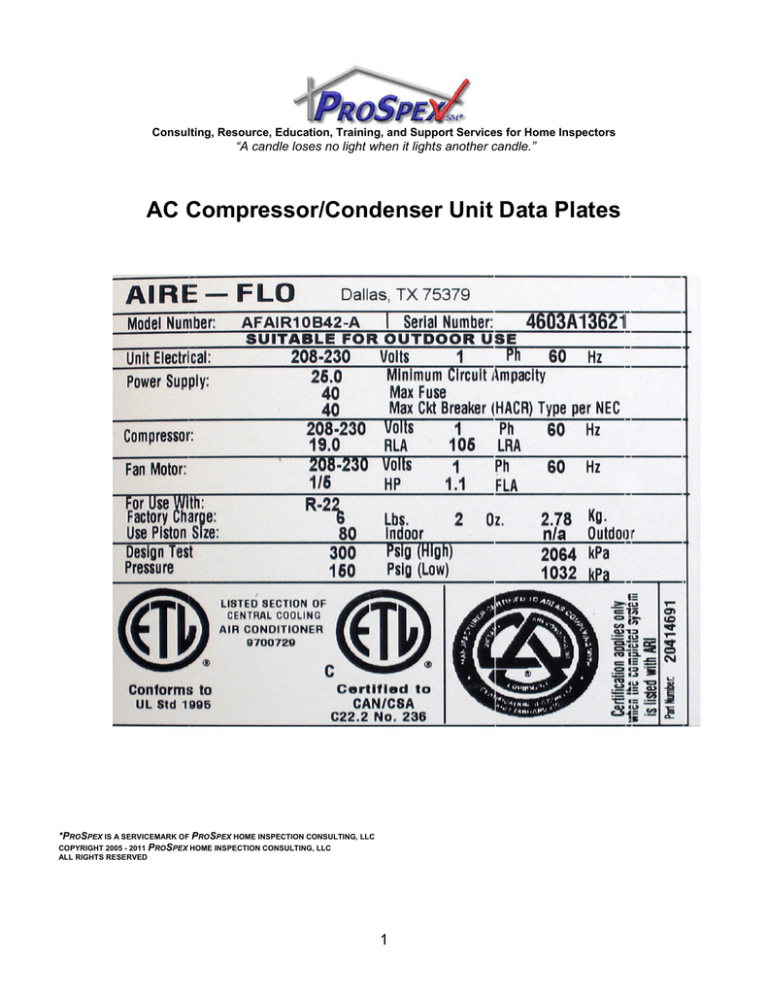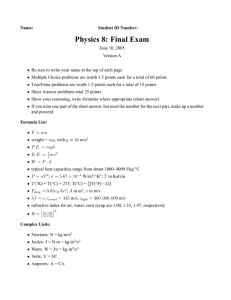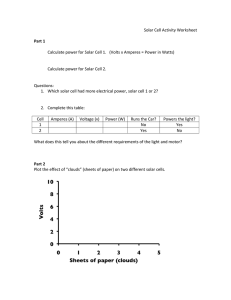
Consulting, Resource, Education, Training, and Support Services for Home Inspectors
“A candle loses no light when it lights another candle.”
AC Compressor/Condenser Unit Data Plates
*PROSPEX IS A SERVICEMARK OF PROSPEX HOME INSPECTION CONSULTING, LLC
COPYRIGHT 2005 - 2011 PROSPEX HOME INSPECTION CONSULTING, LLC
ALL RIGHTS RESERVED
1
Home inspection standards typically do not specifically refer to the information on
compressor/condenser unit data plates. However, understanding data plate information
is essential for confirming that the overcurrent protection for the unit is of the proper
ampere rating and type.
In addition, having a working familiarity with the data plate information provides an
inspector with a broader understanding of air conditioner sizing and installation
requirements as well as how air conditioning systems work.
•
Model: not required
•
Serial number: not required
•
Age: not required
•
Tonnage: not required
•
Electrical information: necessary to determine correct conductor
size and overcurrent protection device type and size to conform to
the manufacturer’s requirements
On the data plate you will typically see a number of multiple letter
abbreviations such as:
•
VAC - Voltage Alternating Current
•
HZ – 60 Hertz The term “hertz” refers to the number of cycles per
second for the alternating current. The data plate indicates 60 hertz.
•
PH – Phase 1 (single phase) The generation of AC electric power is
commonly three phase, in which the waveforms of three supply
conductors are offset from one another by 120°. These three
conductors are commonly housed in a single cable assembly or
conduit but may also be separately housed or spaced in open-air,
such as between utility poles. Standard frequencies are either 50 or
60 Hz. The voltage across a pair of these conductors or between a
single conductor and a neutral conductor is single phase electric
power.
•
LRA - Locked Rotor Amperes: This refers to the inrush amperes that
are drawn when an AC motor is started with full voltage applied.
This inrush current can be many times higher than the full load
amperes. It also refers to the amperes the motor would draw if the
rotor of the motor were seized and could not turn.
FLA - Full Load Ampere is 1.1 amperes. This amperage is the current
that the motor will draw when it is loaded up to its rated horsepower.
2
As the torque on a motor increases, the amperage required to power
the motor also increases. When the full-load torque and horsepower
are reached, the corresponding amperage is termed the “full-load
amperage. The FLA is used to select the correct wire gauge, motor
starter, and overload protection devices necessary to serve and
protect the motor. This is also referred to as the Running Load
Amperes and should not be confused with the Rated Load Amperes.
•
HP - Horsepower
•
HACR - Heating, Air-Conditioning, Refrigeration: This abbreviation is
used to designate circuit breakers which meet requirements
specified by Underwriters Laboratories (UL) for breakers used to
protect the circuit components of typical heating, air-conditioning,
and refrigeration equipment. These include compressor motors and
motors connected in group motor applications.
•
Ton: This is a unit of refrigeration capacity corresponding to the
removal of 12,000 Btus per hour so named because it is equivalent in
cooling effect to melting one ton of ice in twenty-four (24) hours.
•
Btu - British thermal unit: This is a standard measurement of the
heat energy required to raise one (1) pound of water one degree
Fahrenheit (1° F).
The data plate pictured indicates the following about the unit:
•
The manufacturer is Aire-Flo.
•
The Model Number is AFAIR10B42-A.
•
The Serial Number is 4603A13621. In this example, the date of
manufacture is coded into the serial number in the third and fourth
digits – 03. This indicates that this unit was manufactured in 2003
and is approximately two (2) years old. The method used to indicate
the date of manufacture on the data plate varies among
manufacturers. Some may clearly indicate all four digits of the year,
others, as in the example used here, will code the last two digits of
the year into the serial number, and there are still others who choose
to use a letter code in the serial number to indicate the year.
•
Be careful not to confuse other dates which may appear on the data
plate such as those that refer to certain standards like those of UL
(Underwriters Laboratories), ANSI (American National Standards
Institute), the AGA (American Gas Association), or other independent
research, testing, and certification organizations with the
manufacturer’s date of manufacture.
3
•
For a nearly comprehensive guide to the age of both heating and
cooling equipment manufactured between 1960 and 2000, you can
purchase Preston’s Guide from the online store at www.ashi.org.
•
It is suitable for outdoor use.
•
The unit is designed and intended to operate using 208-230 volts,
single phase, 60 hertz power. This number is known as the
nameplate or data plate voltage. The 22 volt range (208-230 volts) is
based on the fact that there may be voltage changes on a given
power distribution system due to changing loads conditions within a
house and on the utility that provides the power. Motors are
designed with a 10% tolerance for voltage above and below the rated
nameplate value.
•
The power supply to the unit must be capable of carrying a minimum
of 25.0 amperes.
•
The maximum fuse size for overcurrent protection is 40 amperes.
•
The maximum circuit breaker size for overcurrent protection is 40
amperes and the circuit breaker must be a HACR type as per the
NEC.
•
The RLA - Rated Load Amperes is 19 amperes. This refers to the
rated current resulting when the motor-compressor is operated at its
rated load, rated voltage, and rated frequency. The RLA provides the
installer and service personnel with information necessary to
determine whether the unit is operating in accordance with the
proper manufacturer’s rating for the unit. Air conditioners draw
approximately 6.5 amperes per ton of cooling capacity; therefore, if
the RLA is known but the tonnage is unknown (not indicated on the
data plate), the approximate tonnage of the unit can be obtained by
dividing the RLA by 6.5. Conversely, if the tonnage is known but the
RLA is unknown, multiplying the number of tons by 6.5 will yield the
approximate RLA.
•
The condenser fan motor is a single phase 1/5 horsepower unit
operating on 208 – 230 volts, 60 hertz with an FLA of 1.1
•
The number of tons of cooling of the unit is not specifically listed on
the data plate (although it is typically coded into the serial number);
however, the RLA is listed. So, we can divide the RLA of 19.0
amperes by 6.5 (approximate amperes per ton) and we obtain 2.92.
Rounding up, this gives us approximately 3 tons of cooling for about
1350 square feet of main level living space and 1350 square feet of
unfinished basement or one ton of cooling for every 450 square feet
of above-ground living space. In this case, given the dry Colorado
climate and the design parameters of the house, this unit is probably
adequately sized for the home.
4
•
The compressor horsepower is not indicated. However, it typically
requires about 1 HP per ton, or for this unit, about 3 HP.
•
The LRA is listed as 105 amperes.
Bigger Isn’t Always Better
Oversizing a compressor can result rapid/short cycling leading to reduced compressor
life due to more frequent compressor start-ups and poor cooling performance since
short cycling doesn’t allow the removal of as much humidity from the house air.
Cold, damp indoor air when the system is operating and a compressor that short cycles
(turns on and off frequently – every five minutes or so) may be an indication of an
oversized compressor. An undersized compressor will run constantly attempting to
provide enough cooling and will wear out sooner.
The ASHI Training Manual states that, “Two surveys have shown that one third to one
half of all residential air conditioning systems are oversized.”
However, making any comments or recommendations regarding the adequacy of the air
conditioning based solely on the indicated or estimated tonnage exceeds the ASHI
Standards and may increase your liability exposure.*
Specific conditions such as rapid or short cycling of the compressor and a noticeably
damp indoor environment indicating that the air is not being dehumidified by the air
conditioning system or a system that runs constantly in an attempt to cool the house
may form the basis to recommend further evaluation of the system by a qualified HVAC
contractor.*
*See the ProSpex article Air Conditioner Compressor Sizing in the HVAC section of the ProSpex
website at www.prospex.us for additional information on compressor sizing.
5



